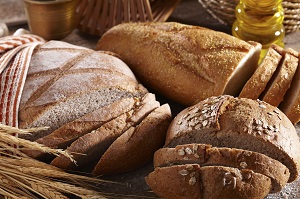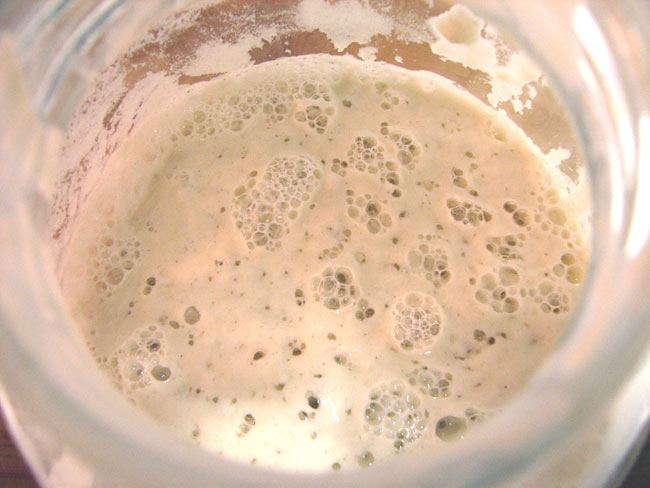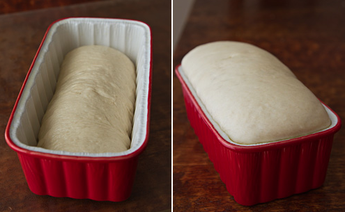
Bread-making is making a comeback in many people’s homes for several reasons. While plenty of inexpensive bread is available in stores, and it is so easy to pick up a loaf on the way home from work, I believe people have become dissatisfied with the quality of most major bread brands. That is not to say that there are not some great loaves of bread out there, and the rise of the artisan bakery is a welcome addition to the food industry. In the case of bread, those great loves come at a cost.
My favourite bread has always been sourdough. It’s just my luck that they are also harder to find and more expensive. You also have to be careful when trying to purchase sourdough bread to ensure it is authentic, made using Lacto-Fermentation, and not just regular bread with some sour flavour added.
Real sourdough bread is better for you. According to an article in the Journal of Food Microbiology,
“Cereal fermentations also show significant potential in improvement and design of the nutritional quality and health effects of foods and ingredients. In addition to improving the sensory quality of whole grain, fibre-rich or gluten-free products, sourdough can also actively retard starch digestibility leading to low glycemic responses, modulate levels and bioaccessibility of bioactive compounds, and improve mineral bioavailability. Cereal fermentation may produce non-digestible polysaccharides, or modify accessibility of the grain fibre complex to gut microbiota. It has also been suggested that degradation of gluten may render bread better suitable for celiac persons.” ( Volume 26, Issue 7, October 2009, Pages 693-699 )
I know that is a mouthful, but let’s look at it one part at a time. “Fermentation can show significant potential in improvement and design of nutritional quality.” This is all related to the fermentation process, making nutritional components more available. What that means to you is you benefit from greater nutrition from the same amount of food.
The following section states that “sourdough can also actively retard starch digestibility leading to low glycemic responses.” Lower GI foods are better for us, so combining whole grains with sourdough fermentation makes sourdough bread an even healthier choice.
The final part of that long journal paragraph states, “It has also been suggested that degradation of gluten may render bread better suitable for celiac persons.” This is supported by another article from the Journal of Agriculture and Food Chemistry which stated that ” Sourdough fermentation resulted in a solubilization and depolymerization of the gluten macropolymer.” (Gluten Hydrolysis and Depolymerization during Sourdough Fermentation, Claudia Thiele, Simone Grassl, and, and Michael Gänzle*Journal of Agricultural and Food Chemistry 200452 (5), 1307-1314DOI: 10.1021/jf034470z)
While many people may be unable to digest gluten, these journal articles suggest that the bacteria used in sourdough making can and do. Perhaps the fact that slow fermentation and sourdough bread making were replaced in the 1950s with quicker bread-making methods, allowing companies to increase their production and profit, explains the rise of gluten intolerance in our community.
Perhaps it was not a sudden change in people’s ability to digest gluten but a sudden change in the bread we eat. Both the scientific and empirical evidence suggest to me that returning to the traditional methods of making bread, such as slow and fermentation, is better for our health. Making it yourself is better for your budget.
Basic Sourdough Directions
Useful Tips
- Use the best-quality, organically grown flour you can find, preferably freshly ground if possible. I get my flour from Grandma’s Pantry in Capalaba. They have a great selection, and I find them very like-minded.
- Use filtered water (to get any chlorine out of tap water).
- Always allow your culture to come to room temperature before opening and handling, and keep it closed as much as possible.
Essentially, sourdough is made with flour and water. Most bread cultures are used to control the indigenous bacteria naturally present in the flour, which might produce unwanted characteristics such as excessive sourness or a spoiled taste. Adding the cultures will ensure a uniform and more complex flavour development with minimal batch-to-batch variations.
The variety of flour used influences the characteristics of the sourdough, and it is possible to make sourdough with wheat, rye, and other types or mixtures of flour. Other important parameters influencing the attributes of the cultures are time and temperature during the processing. Additionally, it is possible to produce sourdough by adding sugar and salt, which will also influence the result.
Making Your Sourdough Starter
First, you must prepare your sourdough starter using flour, water, and yeast. In some cases, you may also add sugar and/or salt, which can affect the flavour of your final bread. Once you have made your starter, you are ready to take a portion of it and use it to make your bread, following the recipe of your choice. The remaining starter can be stored in your fridge for later use.
Step 1. Preparing the initial pre-dough.
- Mix 500 grams of flour with 500 ml of water (one part flour to one part water) to make one kg of pre-dough.
- Add 0.25 grams of the starter culture or one pinch if using our mini measuring spoons. The starter culture can be dispersed in a small amount of water and then added to the flour, mixing well.
- Cover with a wet tea towel and allow to rest. Depending on the required effect (acidity and flavour development) and flour type, the wheat pre-dough’s resting time should be up to 24 hours at 20-30°C. At 25°C, 12-18 hours are recommended, whereas at 20°C, the time should be increased. For pure rye pre-dough, it is recommended that the resting time be more than 24 hours at a temperature above 37°C. The shorter the resting time, the less sourness (acid production) and flavour components are developed. The dough should be stirred periodically.

Step 2. Feeding sourdough
- Mix 500 grams of flour with 500 ml of water.
- Take 1 kg of the pre-dough and blend it with your new mixture of flour and water, resulting in a total of 2 kg.
- Depending on the bread recipe, additional baker’s yeast may be added together with salt, sugar, and other ingredients.
- Cover with a damp tea towel and let it rest. Stir the dough occasionally to prevent indigenous yeasts from developing, and leave it for 4 to 6 hours at the same temperature used for preparing the pre-dough. The shorter the time, the less sourness and flavour components are developed.
Now you have a sourdough mother and are ready to make bread using this as your leaven. Following your bread recipe, add the required amount of sourdough mother (leaven) to your other ingredients. Allow to rise for the recommended amount of time in your recipe, or for sufficient time to achieve the desired rise.
Preparation of the bread

I have used this sourdough mother (leaven) to make bread, either with or without additional baker’s yeast, with good results. The addition of baker’s yeast speeds up the rising process. Without the yeast, I prefer to let my bread rise for 12 to 24 hours, depending on the type of flour I use. Rye flour always takes longer to rise. Slow-fermentation bread is also easier to digest as the gluten and other difficult-to-digest proteins are partially broken down during fermentation. This may explain why many people with gluten intolerance can eat sourdough bread with little to no adverse effects.
Basic Bread Recipe
Ingredients
- 750 grams of wholemeal flour
- One tablespoon of dried baker’s yeast (optional)
- One-half teaspoon of salt
- Two cups of sourdough pre-dough
- One and a quarter cup of water
Directions
Place the flour and salt into a bowl and mix. Make a well in the centre, add your sourdough starter, and mix in. Add one cup of your water and mix it in. Add additional water as necessary until a smooth, elastic dough forms. If using yeast, mix it with the water before adding it to your sourdough starter or flour mix.
Tip the dough out onto a floured surface and knead for several minutes. Knead until it is smooth and elastic. Under-kneaded bread can collapse, so don’t skimp on this step.
Once your dough is the right texture, place it in a clean, oiled bowl to rise. This is not a quick bread that uses commercial yeast. You’re using sourdough starter, so expect this to take some time.
Once your bread has risen for the first time, punch it down, then turn it out again. Cut the dough in half, form it into loaves, and place them in two oiled bread tins. Cover with a clean, damp tea towel and allow to rise for at least six hours. The longer you leave the bread, the better. The best results are achieved when you make the dough one day and bake it the next, allowing it to rise for 12 to 24 hours.
Bake your bread in an oven that has been preheated to 200° to 220° C. This should take about one hour. Your bread is done when you can remove it from the tin, tap it on the bottom, and hear a hollow sound, similar to a drum. You can also use a temperature test to see if your bread is cooked through. Use a thermometer to check the internal temperature, which should be 90° C. Once done, remove your bread from the tin and allow it to cool on a rack, allowing air to circulate it.
The use of baker’s yeast will result in lighter, fluffier bread. Sourdough bread is different, and if you have someone who is used to white bread that is as light as a feather, real bread might be a shock to the system. A bit of yeast will help with the transition.
For me, bread-making is a must-have skill for anyone wanting to live a more sustainable and independent life. I remember being in suburban Logan, just south of Brisbane, when floodwaters cut us off for a few days. The shops ran out of food, and no deliveries could get through. We still had fresh bread every day, and so did the neighbours.
As always, live well.
Valerie
I love authentic sourdough and you’re right, it is expensive to buy. Could you share how to make the starter culture. I’ve heard that people have kept feeding their cultures that once belonged to their parents.
Enjoying your blog.
E
I have had my sourdough mother going for quite some time. I started it with a Sourdough Culture (bacteria) that you can buy and then just followed the directions. What I am going to do is start another one and take photographs of the steps as I do them, so you can see what it is supposed to look like. Then I can give you step by spet directions, illustrated. You can get the culture from Green Living Australia here: https://www.greenlivingaustralia.com.au/sourdough-culture-5-grams
Hi, we don’t eat a lot of bread so would only be making one loaf at a time. Would I be best to halve the amounts at each step so I don’t end up with a mountain of Pre dough? Also, with storing remaining pre dough, how do I store it? Large jar in fridge?
Thanks, Nicki
Hi Nicki,
Yes, you can reduce the amounts to get a smaller mother.
I store mine in the fridge in a large mason style jar. I travel a lot, teaching, so I am away from home for days at a time on a regular basis. When I get home on a Saturday night, I take my mother out of the fridge and let it warm up. I then feed it before I go to bed. It is then ready for me to use to make bread with on Sunday.
Valerie
Thanks for that. I live alone and was wondering how I could get away with not making bread everyday
You can feed you mother once a week and keep it in the fridge. You can then make bread once a week when you take it out to feed it.
Valerie
Hi there! Such a nice write-up, thank you!
Hi there! Such a wonderful write-up, thanks!
What weight is 2 cups of predough please?
I am also struggling with the above written instruction as there is no mention of discarding?
Help please
Thanks Raye
Hi Ramey,
I have never weighed my two cups when making bread. I just pour my mother out of the jar into the cup. In regards to discarding, have a read of my other blog post on sourdough, My Weekly Sourdough Ritual. It might help.
I only discard if I need to feed my mother and I am not going to make bread. If I keep my mother out at room temperature, I need to feed her every day, so I can either make bread every day or discard. In actual fact, I never discard my discard. I use it to make sourdough pancakes. If I keep my mother in the fridge, I need to feed her once a week.
I hope this is of assistance.
Valerie
Hi, my mother is 3 years old and I have left it in the fridge untouched for 6 weeks and it revived OK after feeding. I often go weeks at a time without a worry. I might not do that with a young mother though.
Andrew
Hi Valerie,
I was wondering if it is possible to make sourdough bread using a bread machine?
I have always loved sourdough bread the best but have not ever made any.
thank-you,
Carol:
I have never used a bread machine but I see no reason it would not work. As long as you can follow the recipe using the machine, no problem. Remember, sourdough needs longer to rise, both the first and second time.
Valerie
When you first make the mother, how long do you leave it out ?
Before putting it away. Is it meant to bubble and make more then the 500g that you start with.?
Hi Alison:
The short answer is 24 hours; then it will need to be fed. However, if you put it in the fridge, you can drop the feeding to once a week.
Valerie
I loved the image of taking your “mother” out of the fridge and feeding her!!
I’m all kinds of confused now. I went to your class recently and what I have written down is vastly different from whats in the blog. I really have no idea what I’m doing.HELP!!!!!
Hello Shane
If you went to one of my events, you should have my phone number. Give me a call. If you don’t have my number, call Green Living Australia tomorrow, after 1:00 am, and I will be there. 07 3808 2576.
We will have you sorted out in no time.
Valerie
Hi Valerie,
So are you suggesting that Sourdough bread is pretty much classified as gluten free?
Do you know what the difference is to the sourdough that is actually marked gluten free? …. 😊 and one more question …. if I needed to make gluten free would I just substitute with gluten free flour?
Thank you so much Valerie!
Anita
Hello Anita,
It is not that it is gluten free, the gluten is still there, however, it is being digested, broken down by bacteria, making it more suitable for human consumption. The bread that is marked gluten free is make with a flour that does not have gluten it is at all. Many people who are gluten intolerant can eat sourdough bread made with flour with gluten because the peptides in the gluten that cause the issue are digested by the bacteria. It is important to remember that gluten intolerance and celiac disease are two different things.
Hope this helps
Valerie